Содержание
- 2. Anglo-Saxon Period (5th – 10th centuries)
- 3. The British history is considered to begin in the 5th century, when the country was invaded
- 4. Lyric Poems: “Widsith” “Seafarer” “The Wanderer” “Deor’s Complaint” “The Wife’s Lament” “The Husband’s Message”
- 5. Heroic epics: The works were focused on the deeds of the brave and heroic warriors. “The
- 6. Riddles: “Hundred Riddles” by St. Aldhelm.
- 7. POETRY Poetry has survived in 4 manuscripts: “The Song of Beowulf” “Exeter Book” “Caedmon Book”: “Vercelli
- 8. PROSE The Venerable Bede: “Ecclesiastical History of the English People”
- 9. Alfred The Great encouraged : - “The Anglo-Saxon Chronicle”
- 10. Aelfric wrote religious talks: 1. “Homilies” 2. “Lives of Saints”
- 11. Alcuinus: 1. “Rhetoric” 2. “Grammar” 3. “Didactics”
- 12. Medieval Period (11-15 cent) Anglo-Norman Period (11-13 cent) Pre-Renaissance (14-15 cent)
- 13. Anglo-Norman Period (11-13 cent) The Normans came from the north-west of France. They brought the culture
- 14. Sir Thomas Malory: “Morte D’Arthur “ (Death of Arthur) Printed in 1485
- 15. The literature of the Church was scholastic, moralistic, and it supported the feudal system. The books
- 16. Pre-Renaissance (14th-15th centuries)
- 17. The 14th century was a difficult time for England. The country was waging the Hundred Year’s
- 18. William Langland: “The Vision of Piers the Ploughman”
- 19. John Gower: He wrote in three languages: “Speculum Meditantis” – in French “Vox Clamantis” – in
- 20. Geoffrey Chaucer (1340 – 1400) He was the greatest writer of the 14th century. He was
- 21. Chaucer’s art has three periods: The French period – imitation of French romances The Italian period
- 22. LITERATURE OF THE RENAISSANCE (16th-17th century)
- 23. In the 15th-16th centuries capitalist relations began to develop in Europe. The decay of feudalism and
- 24. The Rise of the Renaissance (1500-1558) Thomas Wyatt and Henry Surrey introduced the sonnet in the
- 25. The Height of the Renaissance (1558-1603)
- 26. William Shakespeare (1564-1616)
- 27. William Shakespeare (1564-1616) His literary work can be divided into three periods: 1590 – 1600 1601
- 28. 1590 – 1600 This period was marked by optimism: Comedies: “The Comedy of Errors” (1592) “The
- 29. The historical chronicles: “King Henry VI” (part II) 1590 “King Henry VI” (part III) 1590 “King
- 30. 1601-1608 Four great tragedies: The tragedies reflect the deep, insoluble contradictions of life, the falsehood, injustice
- 31. 1609 – 1612 The plays of this period differ from everything Shakespeare wrote before. He still
- 32. The Decline of the Renaissance (1603-1649) John Milton (1608 – 1674): “Paradise Lost” “Paradise Regained” “Samson
- 33. Ben Jonson (1572 –1637) He wrote over 20 plays alone, and others with other playwrights. Among
- 34. John Donne (1572 –1631) A group of poets, known as the Metaphysical Poets, wrote less beautiful
- 35. LITERATURE OF THE ENLIGHTENMENT (The 18th century)
- 36. The Enlighteners defended the interests of the common people – craftsmen, tradesmen and peasants. Their criticism
- 37. Early Enlightenment (1688-1740) This period saw a flowering of journalism (J.Addison and R.Steele) and satirical genre.
- 38. Daniel Defoe (1660-1731) He is rightly considered the father of the English and the European novel:
- 39. Jonathan Swift (1667-1745) He was the greatest satirist in English literature. “Journal for Stella” (1710-1713) –
- 40. Mature Enlightenment (1740-1750) Sentimentalism The didactic social novel was born in this period. Samuel Richardson: “Pamela,
- 41. Late Enlightenment (1750-1790) (Sentimentalism) The writers expressed the democratic bourgeois tendencies of the time. They also
- 42. PRE-ROMANTISISM (The end of the 18th century)
- 43. The Gothic School: Horace Walpole: “The Castle of Otranto” Ann Randcliffe: “The Mysteries of Udolpho” Mathew
- 44. Robert Burns (1759-1796) He is a national poet of both Scotland and England. “The Scots Musical
- 45. William Blake (1757-1827) “Poetical Sketches” “Songs of Innocence” “Songs of Experience” “The Marriage of Heaven and
- 46. LITERATURE OF THE EARLY 19th CENTURY ROMANTICISM
- 47. Lakists William Wordsworth (1770-1850), Samuel T. Coleridge (1772-1834), Robert Southey (1774-1843) formed the “Lake School”, so
- 48. William Wordsworth (1770-1850) “Lyrical Ballads” (1798) “Westminster Bridge” “London, 1802” “The Daffodils” “The Prelude”( in 14
- 49. Samuel T. Coleridge (1772-1834) “Lyrical Ballads” (1798) “The Rime of the Ancient Mariner” “Christabel” “Kubla Khan”
- 50. Robert Southey (1774-1843) He was a poet who also wrote biographies, histories and left 109 volumes
- 51. George Gordon Noel Byron (1788-1824) He is the greatest romantic revolutionary poet of England. Byron’s creative
- 52. The London Period (1812-1816) “Childe Harold’s Pilgrimage” – the first two cantos. “Hebrew Melodies” “The Corsair”
- 53. The Swiss Period (May-October 1816) “Childe Harold’s Pilgrimage” – the third canto. “The Prisoner of Chillon”
- 54. The Italian Period (1816-1823) “Childe Harold’s Pilgrimage” – the last canto. “Cain” “Beppo” “Don Juan”
- 55. The Greek Period (1823-1824) “On This Day I Complete My Thirty-Sixth Year” “Cephalonian Journal”
- 56. Percy Bysshe Shelley (1792-1822) “Queen Mab” “Adonais” “Prometheus Unbound” “The Cloud” “To a Skylark” “The Indian
- 57. John Keats (1795-1821) He wrote poetry of rich detail. 1. “Poems by John Keats” (1817) 2.
- 58. Romanticism in Prose Thomas de Quincey (1785 –1859) Confessions of an English Opium Eater, 1822 On
- 59. Charles Lamb (1775 –1834) Blank Verse, poetry, 1798 Pride's Cure, poetry, 1802 Tales from Shakespeare, 1807
- 60. William Hazlitt (1778 –1830) An Essay on the Principles of Human Action (1805) Lectures on the
- 61. Leigh Hunt (1784 - 1859) Amyntas, A Tale of the Woods (1820)· The Seer, or Common-Places
- 62. Walter Scott (1771-1832) “The Mystrelsy of the Scottish Border” – legends and popular ballads of Scotland.
- 63. His novels are divided into three groups 1. Novels devoted to the Scottish history: “Waverley” (1814)
- 64. “Ivanhoe” “The Abbot” “The Pirate” “The Monastery”, and others 2. Novels which refer to the English
- 65. 3. Novels based on the history of Europe “Quentin Durward” “The Talisman” “Castle Dangerous”
- 66. Jane Austen (1775-1817) “Emma” “Pride and Prejudice” “Sense and Sensibility” “Persuasion” “Mansfield Park” “Northanger Abbey”
- 67. LITERATURE FROM THE 1830s TO THE 1860s VICTORIAN LITERATURE
- 68. Chartist Literature The industrial power of Great Britain continued to grow. The number of factories increased,
- 69. Early Victorian Literature Charles Dickens (1812-1870): The first period: “Sketches by Boz” (1836) “The Posthumous Papers
- 70. The second period: “David Copperfield” “Dombey and Son” “Bleak House” “Little Dorrit” “A Tale of Two
- 71. Elizabeth Gaskell (1810-1865) She wrote the biographies of the Bronte sisters. Novels: “Mary Barton” “Cranford” “Ruth”
- 72. The Bronte Sisters: Charlotte Bronte: “Jane Eyre”, “The Professor”, “Villette”, “Shirley”. Emily Bronte: ”Wuthering Heights”, poems.
- 73. William Makepeace Thackeray (1811-1863) “The Book of Snobs” “Vanity Fair, A Novel without a Hero” “Pendennis”
- 74. Poetry G.A.Tennyson (1801-1892): “Maud” “The Death of Oenone” “In Memorium” “The Idylls of the King” and
- 75. Robert Browning (1812-1889) “Paracelsus” “The Ring and the Book” and other poems
- 76. Elizabeth Barrett Browning (1806-1861) “The Cry of the Children” “Sonnets from the Portuguese” “Aurora Leigh”
- 77. Late Victorians POSITIVISM “Mill on the Floss” “Middlemarch” G. Eliot (Mary Ann Evans):
- 78. Novels: “The Egoist” “Beauchamp’s Career” George Meredith (1829-1909)
- 79. Thomas Hardy (1814-1928) “The Return of the Native” “Tess of the D’Urbervilles” “Jude the Obscure”
- 80. Samuel Butler : “The Way of All Flesh” “Erewhon”
- 81. LITERATURE OF THE LAST DECADES OF THE 19th CENTURY In 1899 Great Britain unleashed the shameful
- 82. Decadence Manifested itself in impressionism, imagism, futurism, symbolism.
- 83. The most widely known manifestation of Decadence in the social life of England was Aestheticism –
- 84. Oscar Wilde (1854-1900) He was the most outstanding representative of Decadence. Novel: “The Picture of Dorian
- 85. Comedies: “An Ideal Husband” (1895) “The Importance of Being Earnest” “A Woman of No Importance” “Lady
- 86. Tragedies “Salome” “The Duchess of Padua” And also: “De Profundis” “The Ballad of the Reading Gaol”
- 87. Fairy tales: “The Happy Prince and Other Tales” (1888) “A House of Pomegranates” (1891)
- 88. Late Victorian Poetry Dante Gabriel Rossetti Christina Rossetti William Holman Hunt John Everett Millais Algernon Charles
- 89. Neoromanticism “Art in contemporary society is only necessary for entertainment”
- 90. Robert Louis Stevenson (1850-1894) The novels: “Treasure Island” “Kidnapped” “The Black Arrow” “Catriona” “The Master of
- 91. Rudyard Kipling (1865-1936) Poetry: “Departmental Ditties” “Recessional” “The Barrack Room Ballads” Novels: “Kim” “The Light that
- 92. Joseph Conrad (1857 –1924) “Lord Jim” “Almayer’s Folly” “An Outcast of the Islands” “Heart of Darkness”
- 93. Socialist Literature William Morris (1834-1896) “Unfair War” Utopian novel: “News from Nowhere” “Poems: “Chants for Socialists”
- 94. LITERATURE OF THE EARLY 20th CENTURY
- 95. The Boer War lasted from October 1899 to May 1902. The English suffered many difficulties and
- 96. John Galsworthy (1867-1933) “The Island of Pharisees” (1904) Trilogies: “The Forsyte Saga” consists of: - “The
- 97. John Galsworthy (1867-1933) Each trilogy has Interludes connecting the novels that compose it. In the first
- 98. Herbert George Wells (1866-1946) “Russia in the Shadows” “The Time Machine” “The Invisible Man” “The War
- 99. George Bernard Shaw (1856-1950) Comedies: “Plays Unpleasant”: “Widower’s Houses” (1892) “The Philanderer” (1893) “Mrs. Warren’s Profession”
- 100. George Bernard Shaw (1856-1950) Three Plays for Puritans: “The Devil’s Disciple” (1897) “Caesar and Cleopatra” (1898)
- 101. LITERATURE BETWEEN THE TWO WORLD WARS
- 102. English writers reacted differently to the complicated and constantly changing situation of the 1910-1930s. Some of
- 103. Modernism James Joyce (1882-1941) “Dubliners” (1914) “A Portrait of the Artist as a Young Man” (1916)
- 104. Virginia Woolf (1882–1941) “Mrs.Dalloway”(1925) “To the Lighthouse” (1927) “Orlando” (1928) “The Waves” (1931)
- 105. D. H. Lawrence (1885-1930) Novels: “Sons and Lovers” (1913) “The Rainbow” (1915) “Women in Love” (1920)
- 106. Modernism in Poetry Thomas Stearns Eliot (1888-1965) “The Love Song of J. Alfred Prufrock”(1917) “The Waste
- 107. Critical Realism Katherine Mansfield (1888-1923) “In a German Pension” (1911) “Rhythm” “The Blue Review” “A Birthday”
- 108. “The Garden Party and Other Stories” (1922) “Lady’s Maid” “The Life of Ma Parker” “The Daughters
- 109. William Somerset Maugham (1874-1965) Novels: “Liza of Lambeth” (1897) “Of Human Bondage” (1915) “The Moon and
- 110. Social Realism Ralf Fox (1900-1937) An important event in the literary life of the 30-s was
- 111. There are many novels and poetry about war. These writers are known as “lost generation”. There
- 112. Richard Aldington (1892-1962) (Lost Generation) “The Times Literary Supplement” “Death of a Hero” (1929) “The Colonel’s
- 113. George Orwell (Eric Arthur Blair) (1903-1950) He was one of the first British writers who realized
- 114. John Boynton Priestley (1894-1984) He wrote more than 40 plays, the most significant of them “Dangerous
- 115. Aldous Huxley (1894-1963) “Crome Yellow” (1921) “Antic Hay” (1923) “Point Counter Point” (1928) “Brave New World”
- 116. Archibald Joseph Cronin (1896-1980) “Hatter’s Castle” (1931) “The Stars Look Down” “The Citadel” (1935) “The Keys
- 117. Charles Percy Snow (1905-1980) “Death Under Sail” (1932) “The Light and the Dark” (1947) “Time of
- 118. Graham Greene(1904-1991) The “serious novels”: “The Man Within” (1929) “England Made Me” (1935) “The Power and
- 119. Graham Greene (1904-1991) “The Ministry of Fear” (1968) “The Comedians” (1966) “The Human Factor” (1978) “Getting
- 120. James Aldridge (b. 1918) “Signed with Their Honour” (1943) “The Sea Eagle” (1944) “The Diplomat” (1949)
- 121. LITERATURE FROM THE 1940s TO THE 1970s
- 122. The Second World War influenced greatly the ideological and economic life of Britain. During the war
- 123. Socialist literature Jack Lindsay (1900-1990) “Novels of the British Way” “Betrayed Spring”
- 124. “The angry young men” The English literature of the 1950s tended to reflect some of the
- 125. John Osborne (1929-1994) Plays: “Look Back in Anger” (1956) “The Entertainer” (1957) “The World of Paul
- 126. The New Wave Drama J. Osborne’s play “Look Back in Anger” marked the beginning of a
- 127. “Working-class novel”
- 128. The working-class novel of the 50s-60s brought new themes into the proletarian English literature. First of
- 129. Alan Sillitoe (b. 1928) “Key to the Door” “Saturday Night and Sunday Morning” (1958) “The Open
- 130. Alan Sillitoe (b. 1928) “Travels in Nihilon” (1971) “Raw Material” (1971) “The Storyteller” (1976) “The Broken
- 131. Sid Chaplin (1916-1986) “The Thin Seam” (1951) “The Leaping Lad” “The Big Room” (1960) “The Day
- 132. Stan Barstow (b. 1928) “A Kind of Loving” (1960) “Ask Me Tomorrow” (1962) “The Watchers on
- 133. The philosophical novel
- 134. Many of the English writers of the period considered philosophical problems in their works: the future
- 135. William Golding (1911-1993) “Lord of the Flies” (1954) “The Inheritors” (1955) “Pincher Nartin” (1956) “Free Fall”
- 136. William Golding (1911-1993) “The Paper Man” (1984) “Envoy Extraordinary” (1956) “Scorpion God” (1971) The Trilogy: “Sea
- 137. Iris Murdoch (1919-1999) “Under the Net” (1954) “The Flight from the Enchanter” (1956) “The Sandcastle” (1957)
- 138. The satirical novel Evelyn Waugh (1903-1966) “Decline and Fall” (1928) “A Handful of Dust” (1934) The
- 139. Muriel Spark “The Public Image” (1968) “The Abbess of Crewe” (1974) “The Takeover” (1976) “The Territorial
- 140. Science fiction
- 141. Science fiction is a try to foresee, to imagine the possible ways of human development, to
- 142. Arthur Clarke (1917-2004) Space travels: “The Sands of Mars” (1951) “A Fall of Moondust” (1961) “2001:
- 143. Colin Wilson (b. 1931) “Necessary Doubt” (1966) “The Mind Parasites” (1976) “The Philosopher’s Stone” (1969)
- 144. John Wyndham (1903-1969) “The Day of the Triffids” (1951) “The Chrysalids” (1955)
- 145. Brian Aldiss (b. 1925) Three “Helliconia” novels (1982-1985): - “Spring” - “Summer” - “Winter”
- 146. LITERATURE OF THE LAST DECADES OF THE 20th CENTURY Postmodernism
- 147. Peculiarities: Re-evaluation of the past experience Writers’ skepticism (the parodying of the works of predecessors) Intertextuality
- 148. John Fowles (b. 1926) “The Collector” (1963) “The Magus” (1966) “The French Lieutenant’s Woman” (1969) “Eliduc”
- 149. Martin Amis (b. 1949) “The Rachel Papers” (1977) “Dead Babies and Success” (1980) “Money” (1984) “Time’s
- 151. Скачать презентацию













































































































































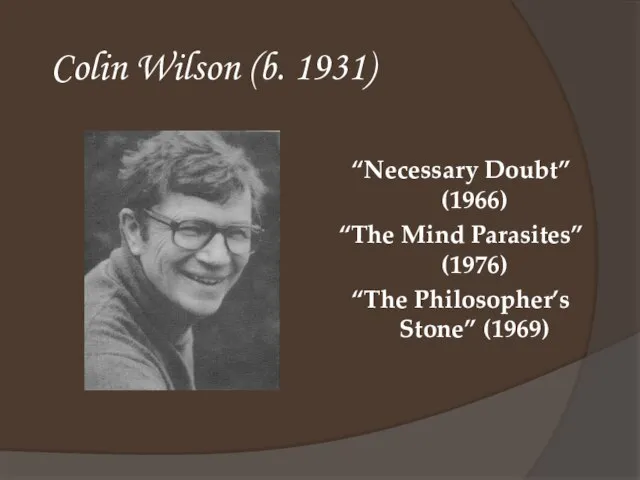
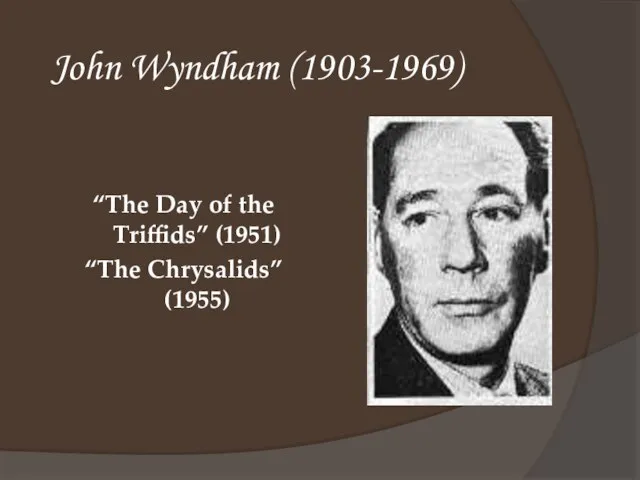

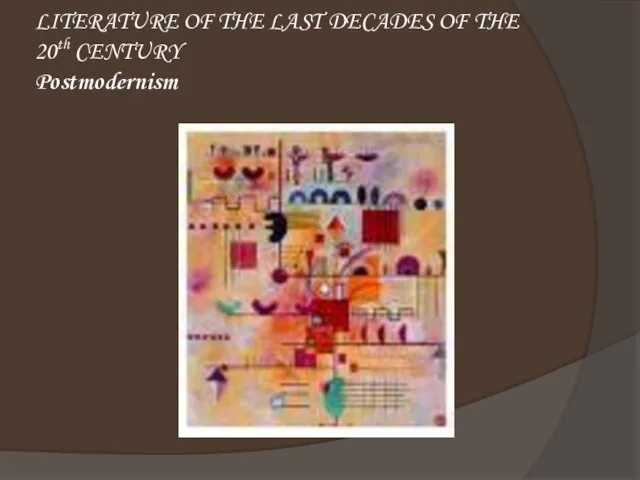
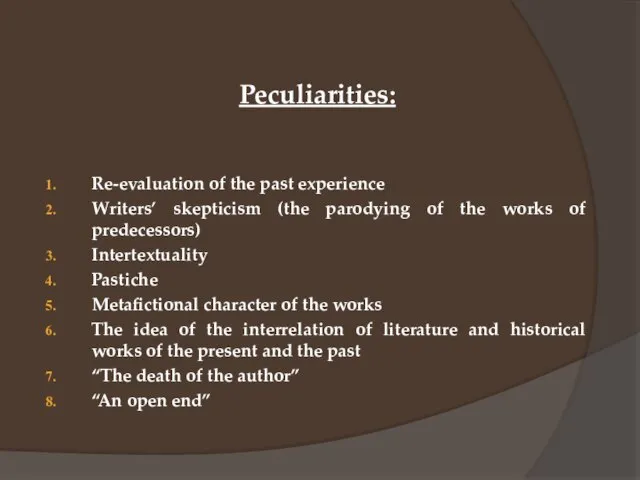
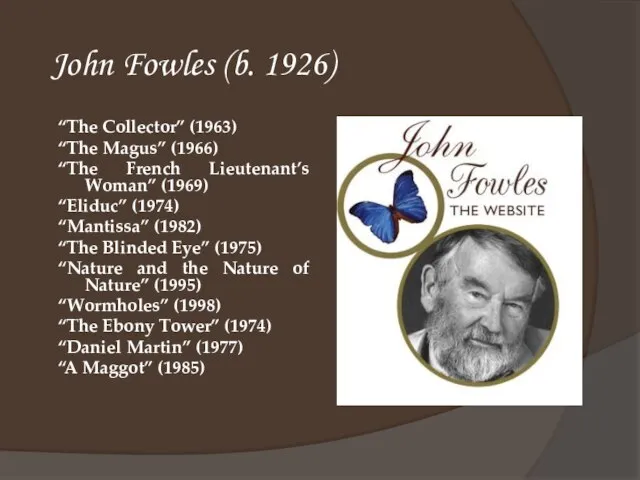
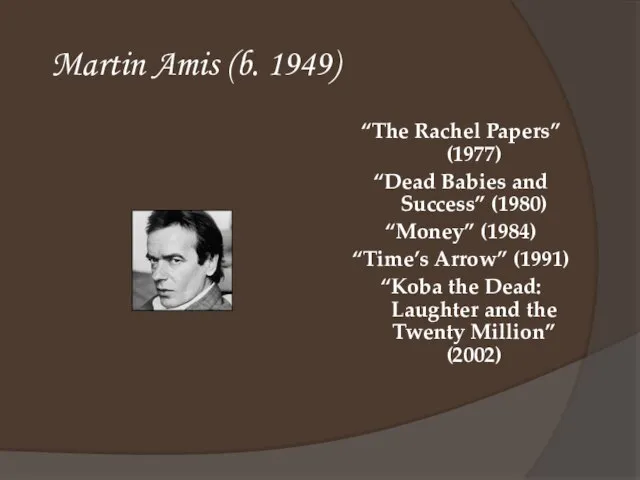
 Политическая сфера. Функции государства
Политическая сфера. Функции государства Римский скульптурный портрет
Римский скульптурный портрет Теоретические основы проектирования методов и технологий обучения
Теоретические основы проектирования методов и технологий обучения Контрактная система
Контрактная система  Презентация на тему Правописание гласных в корне слова
Презентация на тему Правописание гласных в корне слова Презентация на тему Колумбия
Презентация на тему Колумбия Образование в годы войны
Образование в годы войны Профессиональное обучение и дополнительное профессиональное образование
Профессиональное обучение и дополнительное профессиональное образование Антуан Де Сент- Екзюпери Маленький принц. Игра Крестики-нолики
Антуан Де Сент- Екзюпери Маленький принц. Игра Крестики-нолики Дорожная карта завершения СМР и ПНР
Дорожная карта завершения СМР и ПНР Презентация-Трофимов-Дмитрий
Презентация-Трофимов-Дмитрий Значение тренировок для укрепления органов дыхания. Дыхательная гимнастика
Значение тренировок для укрепления органов дыхания. Дыхательная гимнастика Реализация программы «Одаренные дети»
Реализация программы «Одаренные дети» Договор мены (бартер) Войнова Анастасия МЭ 082 ДС 01
Договор мены (бартер) Войнова Анастасия МЭ 082 ДС 01 Корпорация FIRST
Корпорация FIRST Конституционное право
Конституционное право Corel Draw
Corel Draw Урок математики
Урок математики Средства индивидуальной защиты
Средства индивидуальной защиты Инсульт 10 класс
Инсульт 10 класс Потоки
Потоки 11.10.2 – Газ природный 40.30.1 – Услуги по поставке водяного пара и горячей воды (включая холодоагенты) 41.00.2 – Услуги по распределени
11.10.2 – Газ природный 40.30.1 – Услуги по поставке водяного пара и горячей воды (включая холодоагенты) 41.00.2 – Услуги по распределени Past Simple - Прошедшее простое время
Past Simple - Прошедшее простое время Индустриалды мәдениет
Индустриалды мәдениет Роль адвокатирования конкуренции в развитии эффективной конкурентной политики
Роль адвокатирования конкуренции в развитии эффективной конкурентной политики Виды тропов и стилистических фигур
Виды тропов и стилистических фигур План развития ЮФО 2020
План развития ЮФО 2020 Международная компания Digital Smart Sistems
Международная компания Digital Smart Sistems